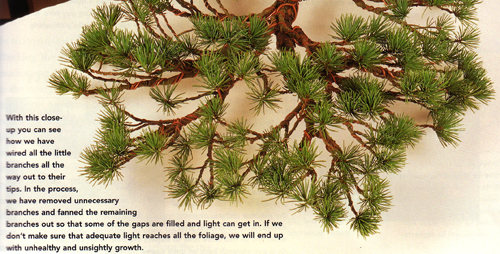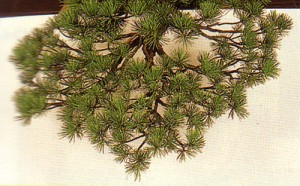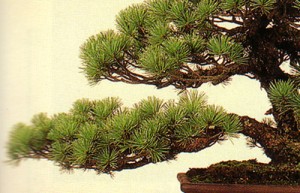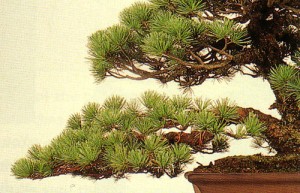
From above, after thinning and wiring. Notice how fine wire is used all the way out to the tips of each twig. The photos in this post are from Bonsai Today issue 92. The artist is Mr. Kiyoshi Yamagami. The tree is a Japanese white pine.
Attention to detail and patience
One of the things that separates world class bonsai from mediocre bonsai is refinement (some bonsai appear over-refined, but that’s another story). Refinement, requires attention to detail and patience and has a lot to do with how you relate to small branches and twigs.

From above, before thinning and wiring. Though this branch already has a pretty good shape, it’s becoming too dense. It’s time to thin and wire once again. The results can be seen at the top of this post.
First you have to develop them….
One of the first steps in refining your bonsai is developing fine branching. This requires time and the aforementioned attention to detail and patience. We recently posted a two year progression on fine branching: here and here.
…then you have to trim and pinch them to keep them clean and healthy….
Foliage that is too dense creates aesthetic and health problems.
…and then you have to wire and separate them
Wiring and separating fine branches is essential. Without wiring and separating, fine branches will tend to grow into each other and create a dense jumbled look (see the aforementioned aesthetic and health problems). With wiring and skillful placement, you can create an aesthetically pleasing fan shape and that desirable layered (floating cloud) look that distinguish most quality bonsai.
 The primary branch before thinning and wiring.
The primary branch before thinning and wiring.
 The primary branch after thinning and wiring. Even though the primary branch itself has not been wired and reshaped, the overall effect is much more fluid and open than in the before photo. This is simply due to thinning and skillfully wiring and separating the smaller branches.
The primary branch after thinning and wiring. Even though the primary branch itself has not been wired and reshaped, the overall effect is much more fluid and open than in the before photo. This is simply due to thinning and skillfully wiring and separating the smaller branches.
Need wire?
Stay posted for more on this topic.